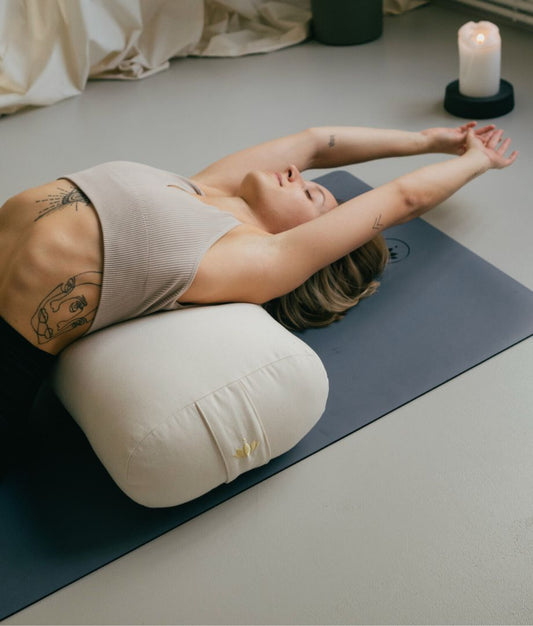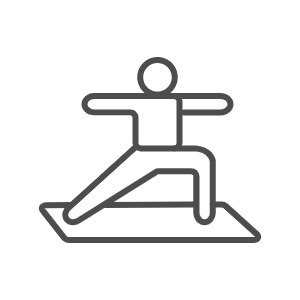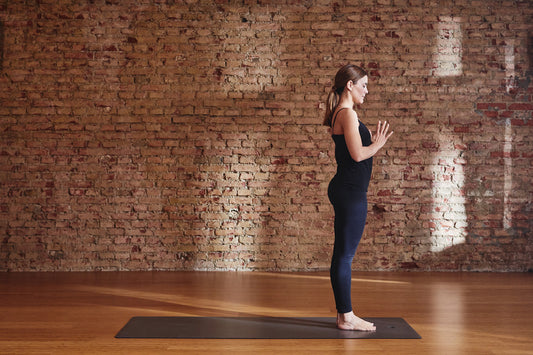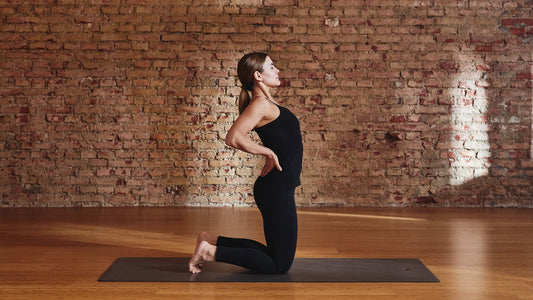
Set-Offers
Save when you buy a set
Shopping cart
Your shopping basket is empty
Yoga

Meditation
Bundles

| Wissen & Wirkung
As soon as the mat is rolled out, time automatically seems to run a little slower: If you belong to the yoga community, you have known and loved this feeling for a long time. But if you've never had anything to do with yoga, you're probably wondering why so many people rave about it. Yoga, is that a sport? a religion? And: What do terms like Pranayama, Hatha , Ashtanga or Kundalini Yoga actually mean?

Does this all sound very confusing? Don't worry, here you can read all about the philosophy behind yoga , different yoga styles and how it differs from Pilates !
In western society, we often associate yoga with well-trained people who seemingly effortlessly bend their bodies into all (im)possible poses while wearing chic sportswear. In fact, the physical exercises are only a fraction of what is really behind yoga and accordingly you don't have to be a super athlete to practice yoga.
Yoga is suitable for everyone , as there are many different variants. Ultimately, it all comes down to finding the yoga that suits your type and health. By the way: Yoga knows no gender, because both men (yogis) and women (yoginis) benefit from the millennia-old practice!
Yoga brings a lot more than you might think at first glance. Many yoga styles are based on certain physical exercises, the so-called asanas. This strains the muscles and strengthens the cardiovascular system .

Yoga is good for your body on the one hand and has a sporty side. The weight loss and tightening effect is a positive side effect of regular yoga, but not the basic goal of a yoga trip, because it's actually about the attitude to life.
Yoga brings improved physical health, but the units are also good for the mind and soul . Because yoga promotes patience, relaxes and at the same time means that you don't get stressed so easily.
In short: Yoga increases awareness of one’s fellow human beings, the environment, but also oneself.
Yoga has a proud age: the discipline originated in India more than 2000 years ago. The word itself comes from Sanskrit and roughly translated means "unity, harmony". According to Indian tradition, yoga is not primarily about the physical aspect, but rather about immersing yourself in your own mind and grasping, understanding and expanding it.
But how do the asanas come into play? Quite simply: The physical exercises are intended to enable long-lasting meditation and also to consciously perceive movements. A 5th-century teaching describes yoga as a path consisting of eight stations :
However, yoga is by no means old and dusty - and that is precisely because it is a practice that really welcomes everyone.
Stretching, stretching, pausing: At first glance, Pilates and yoga don't really seem to differ from each other. So do you actually do Pilates when you stand on the yoga mat? Not quite, because there are slight differences, as well as mixed forms.
First of all, Pilates is much younger than yoga. This variant has existed since the early 20th century and is primarily aimed at strengthening the muscles . With your own body weight, the prana, the energy, is awakened in the middle of the body as well as in the arms and legs. This can be quite strenuous for beginners, but basically it's not about competitive sports, but about executing the movement technique precisely and moving carefully.
The name already gives it away: Yogates is a mixture of Yoga and Pilates elements . It usually starts with yoga asanas, followed by more demanding exercises based on the Pilates concept: It's all about the abdominal muscles! The third block again consists of looser asanas and ends the session gently.
First of all: THE Yoga does not exist, rather many different variants stand side by side on an equal footing. As said before, it's just a matter of which type suits you personally the most. So that you can get a concrete idea, here is a list of the most popular styles .
An Ashtanga session always follows the same order. This consists of very dynamic exercises that work the muscles properly and are guided by laryngeal cleft breathing. This style of yoga is strongly aligned with the path of the eight steps.
The typical 26 exercises in the Bikram style are performed in a very warm room. Around 40°C room temperature ensures that the muscles are relaxed even more and you sweat a lot. Bikram Yoga is doubly good for your health because it has a very detoxifying effect.
When we talk about yoga, we usually have this style in mind. Hatha yoga is ideal for beginners , as the light physical exercises and calm breathing techniques are feasible for everyone and gently introduce the yoga philosophy.
The connection to the spirit is more important here than the physical exertion.

In the Kundalini style, particularly intensive breathing exercises are carried out in addition to the asanas. The prana, the flow of breath or life energy, is directed consciously. Meditation and the repetition of mantras also play an important role here. So the focus is more on the spiritual level.
This variant dives deep into the spiritual world: a trance-like state between sleeping and waking is deliberately created in which one consciously experiences one's own thoughts and feelings without judging. Yoga Nidra does not focus on physical exercises but on meditation.
Ashtanga yoga is the basis for this style. The main difference is that the order of the asanas in power yoga can be made much more flexible. Again, the poses may not look too strenuous, but they quickly make you sweat because the deep muscles are engaged. The asanas are held for a long time and are aimed at strengthening coordination, breathing, strength and balance .
With Vinyasa Flow, the asanas flow into each other and are guided by breathing. The asana sequence is repeated several times at a rather brisk pace. In addition to conscious breathing, Vinyasa yoga also builds and strengthens muscles.
Those who prefer to take it easy are well advised to try Yin Yoga , because this style is very calm .
The positions are sometimes held for several minutes, but the focus is not on physical exertion, but rather on the stretching effect and listening to the body.
As a positive side effect, the joints are strengthened and the connective tissue (fascia) is relaxed.

Now you know about the most common styles, but in the jungle of Sanskrit terms it's easy to lose track. We have collected the most important terms :
Mindfulness, Sanskrit smrti , means an attentive basic attitude. In this context, attention means being aware of the moment and accepting the given circumstances as they are. Because once you can accept the world as it is, it becomes easier for you to recognize your feelings and thoughts without judging them.
The Sanskrit word means "awakening, enlightenment" and is a central element in yoga. Basically, this state of enlightenment is aimed at, in which the state of pure spirit is recognized as the basis for unimagined potential. Of course, enlightenment doesn't come overnight; the way there leads from yoga teaching to regular meditation.
You may have come across terms like heart chakra or third eye. Chakra means "circle, wheel" and refers to the energy centers in the body . The thought behind it: The more energy centers you can open, the closer you get to the state of enlightenment. All chakras have a special meaning.
For example, the third eye can give you better focus if you put your full focus on opening it. By the way: The third eye is in the area between the eyebrows and is the sixth chakra.
A distinction is made between cosmic and personal dharma, or in other words the universal order and one's own purpose in life . Dharma essentially means the rules for coexistence in public and private space. In Southeast Asia, Dharma is interpreted somewhat differently depending on the religion.
This term should probably not be unknown to anyone: Karma means "effect, deed" and states as a principle that all deeds have consequences sooner or later in life. Karma means the principle of cause and effect .
The most well-known mantra is “Om”, but in general, mantra is simply a formulaic sequence of words or individual syllables . The mantra is said or sung over and over again and works well as a meditation technique . By the way, you can also think of your own mantra if you don't really identify with any of the known ones.
When a Buddhist speaks of nirvana, he means stepping out of the cycle of rebirth and awakening in a state of enlightenment. Contrary to popular belief, Nirvana cannot only be reached after death: In principle, one enters this realm as soon as one experiences happiness, completely independent of external circumstances and emotions, and is free from greed, egoism and similar characteristics.
Prana is the life energy that flows through the body. With breathing techniques, called pranayama , the energy can be directed and consciously experienced.
An essential part of the yoga path, samadhi is the realization that all is and always has been one . The state is described by yogis as perception beyond waking, sleeping and dreaming. Samadhi also means that this thought becomes established in the mind.
Zen is also a well-known term, but it is often difficult to imagine anything concrete. It is a branch of Buddhism and has zazen, i.e. meditation while sitting still, as an essential part.
So is yoga an all-rounder? Well, of course it can't heal broken bones or work miracles. However, if you get involved in the philosophy of the unity of body and mind , you will quickly notice that your everyday life changes for the better. Yoga doesn't reduce stress and worries, but you will see that you can deal with it much better.
As a pleasant side effect, some yoga styles also make you strong and flexible, so that you develop a greater awareness of your body and simply feel better thanks to the detoxifying effect.
Yoga is not a competitive sport - and it shouldn't be. If you don't have any experience yet, you can take your time to find your very own style . Once you've found it, you'll realize there's a reason this ancient way of life is still so popular in the 21st century...

Hardly any exercise sequence is as well known as the sun salutation. The activating sequence consists of several asanas that are fluently connecte...
Continue reading
Unfortunately, stress does not stop at anyone in the hectic everyday life. Seemingly endless to-do lists, worries and problems haunt us until the e...
Continue reading
There are no comments yet. Be the first to leave a comment!